What Does A Fencer Wear?
Fencing equipment has evolved through the years and is an integral part of keeping fencers safe. State of the art fabrics, modern designs, technology, and construction methods are tested then implemented for safety. The three weapons (epee, foil and saber) of modern Olympic fencing have basic equipment in common but each has a few items that are distinctly different at the target areas and rules are different.
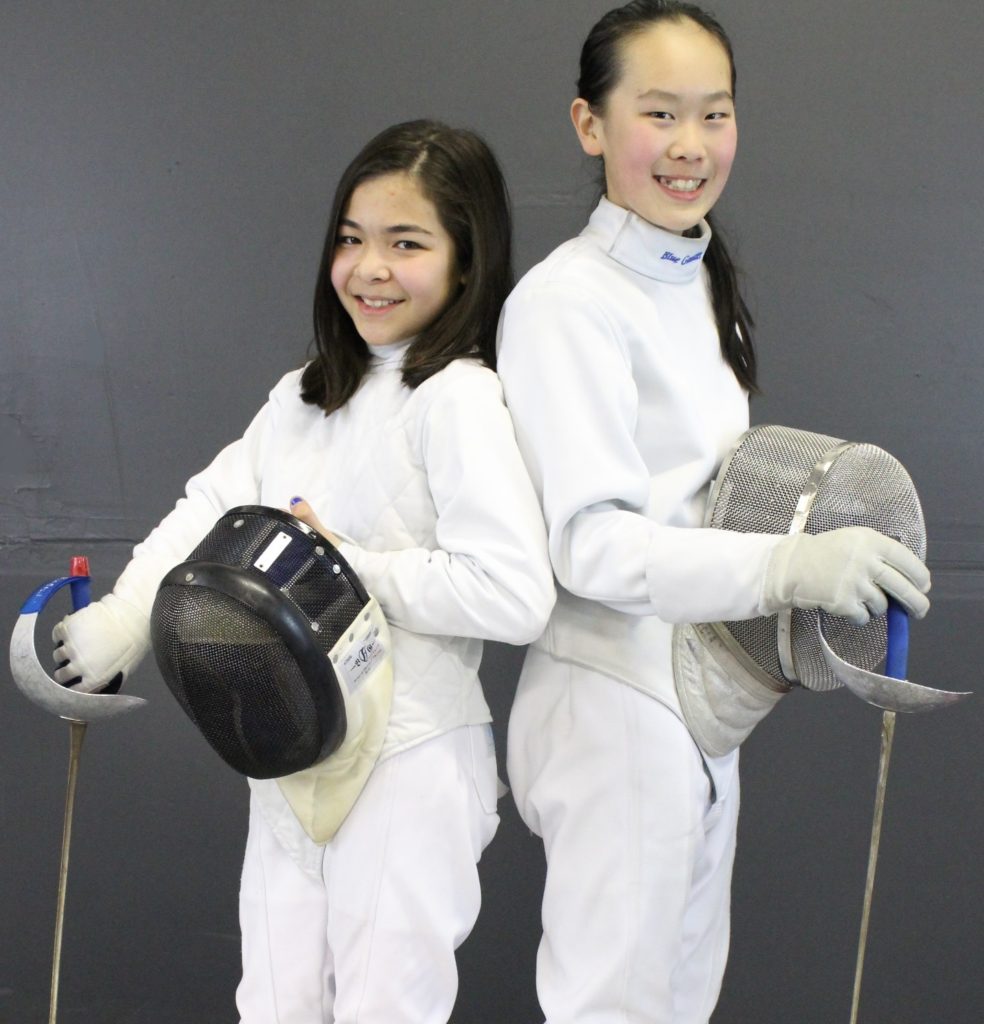
F.I.E or Non F.I.E Equipment?
 When you start to purchase equipment, you will see “FIE” equipment and “non-FIE” equipment. FIE stands for Federation International d’Escrime, the organization that governs fencing. FIE equipment means that the manufacturer has submitted samples to an independent testing lab, the equipment was tested to rigorous standards, set by the FIE, the equipment meets these standards, the lab certifies this equipment, the manufacturer agreed to continue to produce the equipment the same way in the future. Any changes to the equipment manufacturing process requires the equipment to be re-submitted. This testing process is expensive, therefore FIE equipment is the most expensive equipment available from any maker. All FIE equipment has special labels sewn in so you can easily identify FIE gear.
When you start to purchase equipment, you will see “FIE” equipment and “non-FIE” equipment. FIE stands for Federation International d’Escrime, the organization that governs fencing. FIE equipment means that the manufacturer has submitted samples to an independent testing lab, the equipment was tested to rigorous standards, set by the FIE, the equipment meets these standards, the lab certifies this equipment, the manufacturer agreed to continue to produce the equipment the same way in the future. Any changes to the equipment manufacturing process requires the equipment to be re-submitted. This testing process is expensive, therefore FIE equipment is the most expensive equipment available from any maker. All FIE equipment has special labels sewn in so you can easily identify FIE gear.
Non-FIE equipment conforms to many of the same standards as FIE equipment, and some of the manufacturers claim they may surpass some of them . The equipment is “non-FIE” because the manufacturer has not submitted samples to be certified – usually due to the expense and time involved in the testing. Even non-FIE clothing (including masks) is usually required to meet a certain standard of durability to prevent injury.
United States Fencing has determined that the difference between FIE and non-FIE gear is minimal, and does not require FIE gear for national and local competitions. Therefore, non-FIE gear is still legal for competition in the United States. Consequently most fencers in the U.S.A. start with non-FIE gear, only acquiring FIE gear once they plan to fence outside the country, because its much more affordable.
The Basics to Get Started
Below are the basic uniform items needed to get started fencing,
Basic gear to get started:
- Glove
- Practice Mask
- Chest Protector
- Jacket
Most fencing cubs will loan beginners the above basics and a sword to try out the class, Once you’ve decided to continue buy your own then add the knickers. Wear long pants (not fleece) to protect your legs until then.
For best hygiene we recommend you buy your own glove and mask as soon as possible.
1. The Beginner Glove – Glove good for all 3 weapons
First purchase should be a basic glove.
The basic practice glove is specially made with a padding to protect the fingers, knuckles, back of the hand, wrist and a part of the forearm closest to the wrist. Used in all 3 sword weapons, it is inexpensive, between $15 – $22.00. As one advances, upgrade to a weapon specific high quality glove. The basic starter glove usually comes in 5 sizes: xs-s-m-l and xl. Foil and epee gloves are the same, saber gloves for tournaments are made differently.
See how to clean your glove here
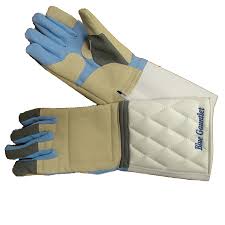
2. The Mask – Practice mask good for all 3 weapons
Second, buy a practice mask.
The practice mask is specially made with a metal coated mesh to protect head area. Known as a 3 weapon mask or an epee mask, it’s special construction along with a padding that keeps the mask as safe and comfortable as possible. The mask is slightly adjustable allowing a custom fit to each person’s head. They come in 4 sizes, s-m-l and xl.
I recommend the mask that has a removeable lining because it can be easily taken out and washed to remove all the sweat and smell from heavy use.
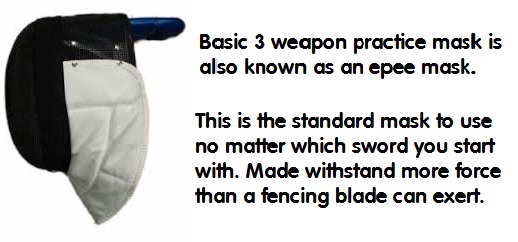
3. The Chest Protector
Chest protectors (often called body armor) are required for women in all weapons, and required for both sexes in foil and epee. Many fencing clubs (including ours) require them for both sexes in saber. The chest is a target area in all 3 weapons of fencing, therefore this lightweight, durable plastic molded piece of protection is a integral part of keeping participants safe.
For ladies I recommend buying one that has small breathing holes around the breast area because it allows sweat and heat build up to escape.
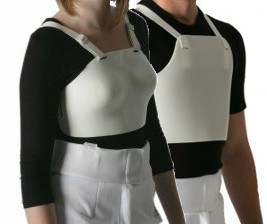
4. The Jacket
The fencing jacket is the same one used for all 3 weapons. When purchasing your own jacket it is important to get the correct weapon hand – either a right handed or left handed jacket as the zipper is sewn on either side.
The zipper is covered so a blade can’t catch on it, the collar is high enough and reinforced to help protect the neck. It features a gorget – a folded fabric is sewn in around the collar to prevent an opponent’s blade from slipping under the mask and along the jacket upwards towards the neck (often referred to as a blade catcher). A safety strap threads beween the legs to prevent the jacket from riding up while fencing.
The different fabrics used are:
1. Stretch Nylon: Offers a little less protection but is light, very comfortable and wears well. They are sold as 350NW nylon (NW stands for newton )
2. Cotton Duck: The least expensive option, cotton shrinks in the beginning when washed, gets dirty easily (bleach or Oxiclean work great on cotton), is a little stiffer than the nylon but unlike nylon, the cotton breathes better and many fencers say it’s more comfortable. Many cotton jackets have a stretchy back panel for comfort.
3. Ballistic Nylon: 800 Newton Nylon is used in FIE gear and is available in Non-FIE gear. It’s heavier therefore offers more protection. They are 800 NW (so withstand up to 800 newtons of puncturing pressure). FIE gear is required at World Cups, all international events and the Olympics.
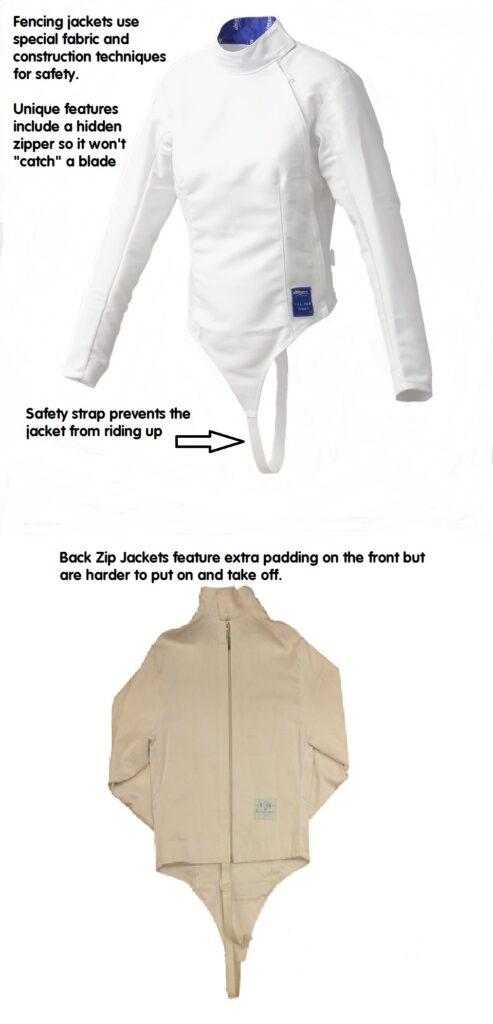
5. The Knickers/Breeches
Fencing pants are called knickers or breeches. They make a huge diffence in your comfort level when fencing. The knickers move and stretch with you. The fabric choices are the same as the jacket.
Built in safety features include a high layered waistband to protect your stomach, belly button and lower back. The pants should completely cover the belly button. Adjustable suspenders keep the protective waistband up and prevent the knickers from creeping down. The bottom of the leg portion must fall below the knee when the knee is bent in a fully extended lunge. Most knickers have a comfy elastic stretch cuff at the bottom of the knickers. The rule (for safety) is, no skin showing on the legs thereby preventing injury.
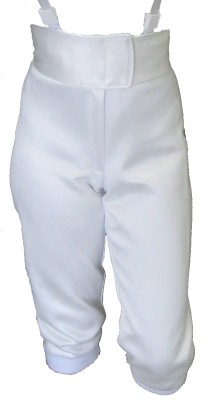
Other parts of the uniform beyond the basics
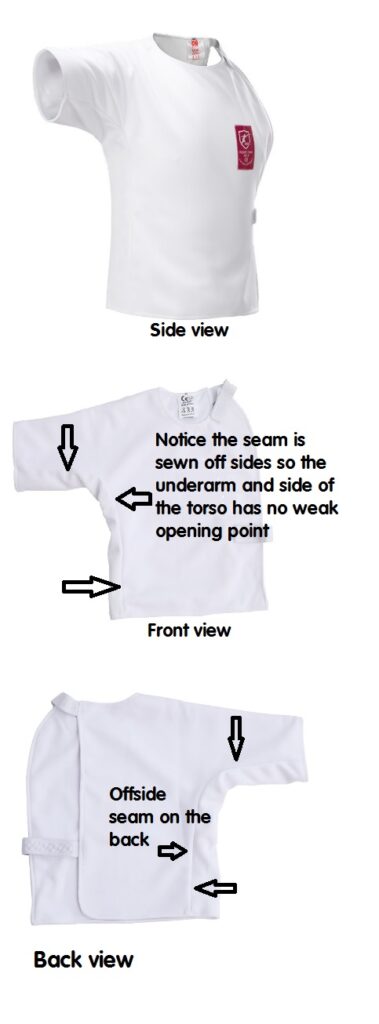
1. The Plastron
The plastron is an underarm protector worn on the weapon arm of the fencer. The seams are offset so there is no weak point (seam) at the underarm pit area. Two layers give added protection. Several models are reversible so it can be used by either a left or right handed fencer. Two styles are offered 1. no collar and 2. with a collar. Many fencers use the collarless model for training purposes as its a little lighter than the collar model. Foil fencers like the collar as the neck area is frequently hit with the point.
The plastron is REQUIRED for all tournaments regardless of which weapon you use.

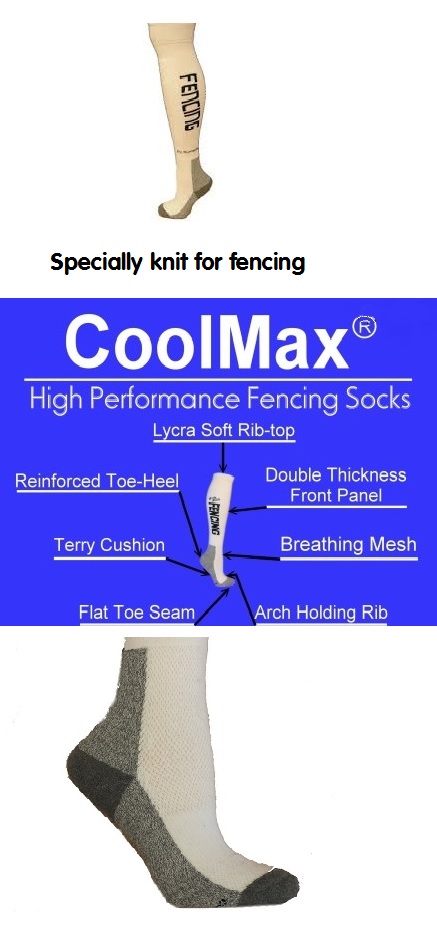
2. The Socks
Long socks that stay up are required for fencing. While you can use soccer socks, fencing socks are very uniquely knit specific to fencing -and they really stay up! Your feet will feel the difference in true fencing socks.
Here’s why:
1. Many features are knit right into the socks.
2. The front of the sock has a double thick panel for protection (great for shins).
3. The heel has extra cushioning knit in to help on the landing
4. Breathing mesh on the front helps heat and moisture escape.
5. Flat toe seam to help prevent blisters.
6. The arch has a special knit rib for more arch support.
7. The top of the sock has a lycra soft rib-top to really keep the socks up.
8. The toe and heel areas are reinforced.
9. Many fencing sock brands use the CoolMax fiber which give the moisture management and wicking performance, helping the feet to stay dry and cool.
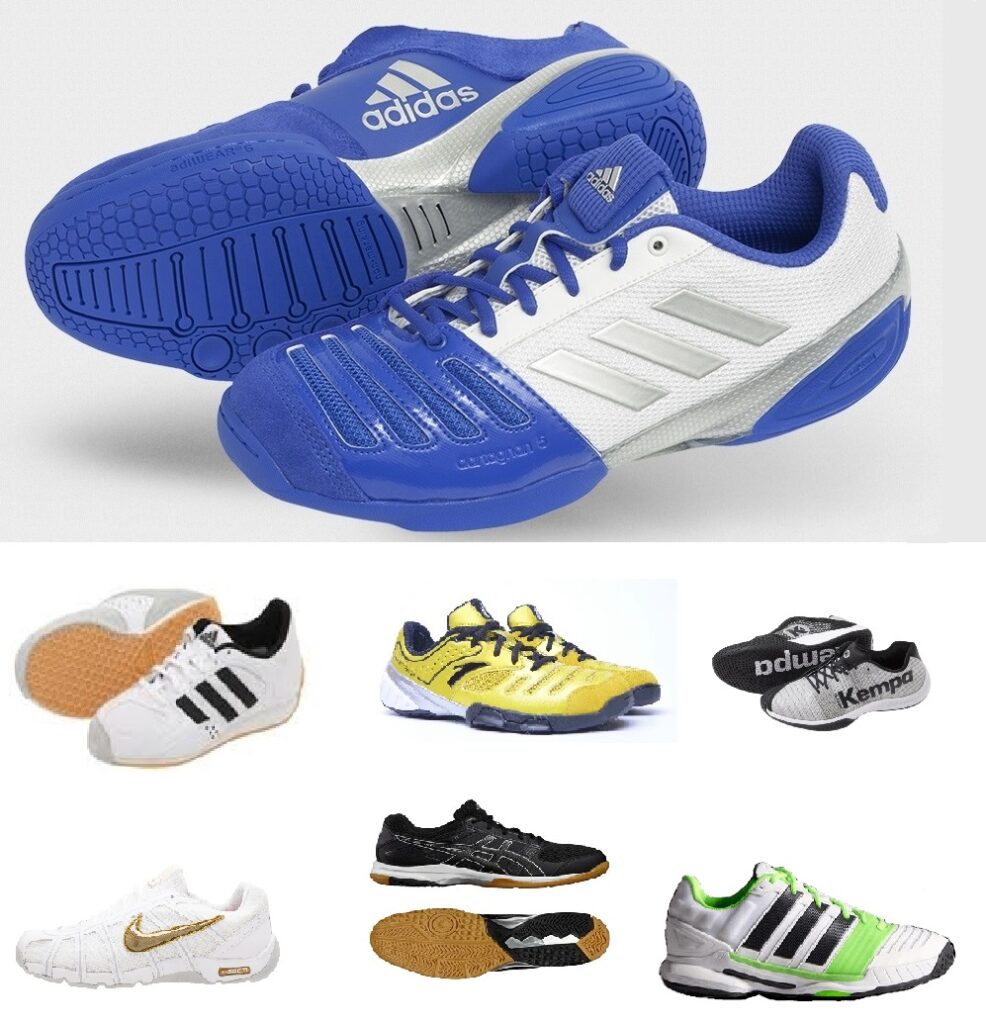
Tips when looking for shoes to use for fencing.
- Gum rubber soles have the best grip.
- Many court shoes and most Adidas fencing shoes have an “outrigger” on the exterior edges that are very effective in helping prevent ankle rolls.
- You need a durable or reinforced inner edge for the “drag” on the trailing foot.
- Don’t use gel insoles or heel insoles, because they don’t breathe and will likely shift one’s balance to the ball of the foot.
- Add a high performance flat insole – your legs, knees, hips joints and lower back will thank you.
- Be sure the shoes are wide enough! Different makers use different widths. Your foot should not be over the edge of the shoe.
- Generally court shoes or volleyball shoes are a good second choice in lieu of fencing shoes.
3. The Shoes
Fencing shoes are heavily debated between fencers.
Keeping in mind the dynamics of the sport (the fencing lunge exerts up to 7x the fencer’s body weight on to their leading heel). It’s important your balance is even, and the ability to stop, start, change direction and have a good grip is crucial. Good lateral support is important so be sure the shoes are wide enough. I often see fencers whose feet are hanging off the edges of their shoes, which increases the risk of an ankle roll and to compensate their footwork deteriorates making a higher risk of injury.
Don’t use running shoes, or any heavily padded shoes. Many shoes shift your balance to the front of the foot. You want to be able to “feel the floor”. Don’t use wrestling shoes, they are flat but made to use on a padded mat, therefore they don’t have enough cushioning, durability or support for fencing.
Adidas has been making fencing shoes longer than anyone else making fencing shoes. They have made many wonderful models.. Other makers are now adapting their court shoes to use in fencing. Kempa and Anta have altered some of their court shoes and now have fencing shoes that are getting good reviews from fencers.
Here is a really good comprehensive guide to fencing shoes that was written in 2016 but was updated in 2019.
